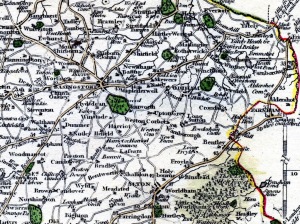Basingstoke a large, antient and populous market town, pleasantly situate in a sylvan part of the county and at the junction of five great roads, whence it commands a very considerable trade. It is a town corporate consisting of a high steward, mayor, recorder, 7 aldermen 7 burgesses and 2 serjeants at mace. The church is a spacious and handsome edifice consisting of a nave, chancel and side aisles, with a low square tower. There are also 2 meeting houses for dissenters. The market house is a tolerably good building with a hall over it where the sessions of the town are held twice a year and where the magistrates meet every Tuesday to transact business. Several seminaries have been instituted here for the education of youth; particularly a free school of some repute; and a charity-school in which 12 boys are clothed maintained and instructed at the expense of the Skinner’s company, of London. Here are likewise 8 well-endowed alms-houses for poor and industrious widows. On an eminence at the northern extremity of the town are some remains of the Holy Ghost chapel a beautiful structure said to have been erected in the reign of Henry VIII but the stile of its architecture is more like that which prevailed in the time of Edward VI. the ony parts now remaining are the south and east walls with an hexangonal tower at the south-west angle.
Basingstoke has a manufactory druggets and shalloons which affords employment to a great number of poor people; it also possesses a considerable trade in corn; the conveyance of which is greatly facilitated by the new canal made from the river Wey in Surrey to this town and opended on the 4th September 1794. The length of this canal to the Wey by which it communicates with the Thames is 57 miles and one quarter; and the expense of cutting it amounted to£100,000 but a considerable part of this sum was expended in forming a tunnel nearly three-quarters of a mile in length, through Grewill-hill near Odiham.
Market Days and Fairs: the weekly market which is considerable for corn is held on Wednesdays. Fairs, Easter Tuesday for sheep, Whit Wednesday and Michaelmas Day for Cattle etc and September 23rd for sheep. There is also a statute for servants on the 10th October.
Bankers: Messers Jeffries and Co draw on Fry and Co,London
Post: The post-office opens at 9 o’clock in the morning and shuts at 10 on the evening.
Principal Inns: The Crown, Maidenhead and Wheatsheaf.
Coaches,Waggons: The mail-coach passes every night at 12 o’clock and changes horses at the Wheatsheaf. There are coaches from several inns in London viz a coach from the Bull and Crown,Holbourn, Tuesday and Thursday and Saturday; at 5 o’clock in the morning; from the Saracen’s Head Snow-hill, Three Cups Bread-street and the Black Lion,Water-lane, daily ; from the Saracen’s Head Friday-street, Monday, Tuesday and Wednesday morning at 4 ; from the Angel behind St Clements daily at 5 in the morning and from the Belle Sauvage, Ludgate-hill daily at 4 in the afternoon. thee are also diligences from the Swan Lad-lane, Three Cups Broad-street, and Black Lion Water-lane, daily. A waggon from the Rose, Holbourn-bridge Monday afternoon and Friday morning and from the BelleSauvage, Ludgate-hill every Saturday afternoon.
Gentlemen’s Seats: Kempshot (Lord Chelmondley) 4 miles; the Vine (W.Chute esq M.P.) 3 miles, Manydown (L.B.Wither esq) 3 miles ; Oakley Hall (W. Bramston, esq) 4 miles; and Tylney Hall (Sir J. T. Long, bart) 5 miles.
Basingstoke is 7 miles distant from Odiham, 8 miles from Overton, 10 from Alton, 12 from Alresford, 16 from Reading and Newbury, 18 from Winchester and Andover and 45 miles 1 furlong from London. The population when last taken (1801) was 2589 and the number of houses 512. On the right is a turnpike road to Reading; on the left to Alton and Winchester.
Text: Crosby’s Complete Pocket Gazetteer of England and Wales or Traveller’s Companion (1807) by the Reverend J Malham. Published by B Crosby and Co, Stationer’s-Court, Ludgate Street, London.
(NOTE : this was the same firm of publishers, owned by Benjamin Crosby, who bought the copyright of Northanger Abbey, then known by the title “Susan”, in 1803 for £10 but never published it. Jane Austen eventually purchased the manuscript back from them . The correspondence between them included her famous letter of April 5, 1809 which she wrote under the pseudonym of Mrs Ashton Dennis thus enabling her to end the letter with the following phrase, I AM GENTLEMEN, MAD.)
Map : Section from Hampshire (1793) by John Cary
Jane Austen References
The Letters
Letter to Cassandra Austen dated 27th October 1798
Letter to Cassandra dated 25th November 1798
Letter to Cassandra dated 18th December 1798
Letter to Cassandra Austen dated 8th January 1799
Letter to Cassandra Austen dated 21st January 1799
Letter to Cassandra Austen dated 25th October 1800
Letter to Cassandra Austen dated 1st November 1800
Letter to Cassandra Austen dated 8th November 1800
Letter to Cassandra Austen dated 20th November 1800
Letter to Cassandra Austen dated 30th November 1800
Letter to Cassandra Austen dated 3rd January 1801
Letter to Cassandra Austen dated 11th February 1801
Letter to Cassandra Austen dated 112th May 1801
Letter to Cassandra dated 20th February 1807
Letter to Cassandra dated 24th October 1808






